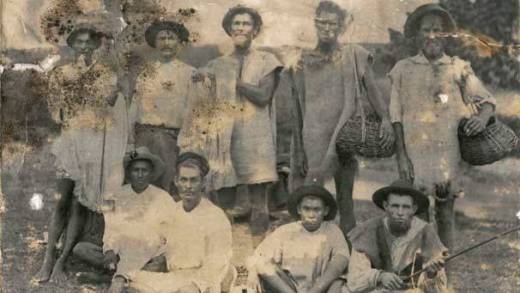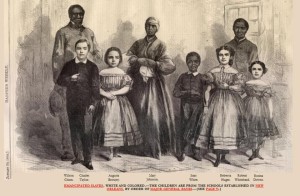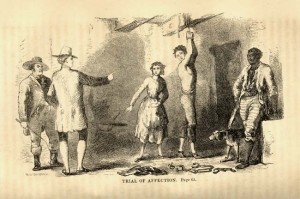
White and Black Slaves in the Sugar Plantations of Barbados. None of the Irish victims ever made it back to their homeland to describe their ordeal. These are the lost slaves; the ones that time and biased history books conveniently forgot.
American slavery has a unique flavor, the flavor of race, the idea that African humans were a different race, a lesser race that could be owned like cattle. But Whites were also treated as slaves, under another name.
(Based on an essay at Radio2Hot.com. Parts of this text are from that essay.)
The concept of racial slavery, that is the treatment of some humans as a different and lesser species is not very old. It appears to have begun when the Christians in Spain needed a way to legitimize Jewish converts. Until recently, under Spanish laws dating to the Inquisition, a “drop of blood” was enough to take away the rights of the descendant of Jews. Some were even made slaves.
This concept proved all to useful in the Americas where humans, initially indigenous
![Slavery in Virginia dates to 1619,[1] soon after the founding of Virginia as an English colony by the London Virginia Company. The company established a headright system to encourage colonists to transport indentured servants to the colony for labor; they received a certain amount of land for people whose passage they paid to Virginia.[2] African workers first appeared in Virginia in 1619, brought by English privateers from a Spanish slave ship they had intercepted. As the Africans were baptized Christians, they were treated as indentured servants. Some laws regarding slavery of Africans were passed in the seventeenth century and codified into Virginia's first slave code in 1705.[3]](http://handbill.us/wp-content/uploads/2016/02/Capture-12-218x300.jpg)
Slavery in Virginia dates to 1619. The London Virginia Company established a headright system. Colonists received a certain amount of land for people whose passage they paid to Virginia. These African workers were brought by English privateers from a Spanish slave ship they had intercepted. As the Africans were baptized Christians, they were treated as indentured servants.
Before the colonies imported Africans as cattle, 100 White children arrived. This was Easter, 1619. Four months later the first shipment of Black slaves arrived. Our history books, and the laws of the colonies made a distinction, the Europeans were called Whites and classified as “indentured servants,” not slaves. The argument was that White folks were either convicted criminals or poor people who agreed to work for a set period of time in exchange for land and rights. Blacks were just animals.
Many of the indentured servants were brought from Ireland. British law held that it was “no more sin to kill an Irishman than a dog or any other brute.” In an issue reminiscent of so many similar stories of the African passage, in at least one incident 132 slaves, men, women, and children, were dumped overboard to drown because ships’ supplies were running low. They were drowned because the insurance would pay for an “accident,” but not if the slaves were allowed to starve.
Religion played its ugly role in the story of White slavery. Christianity justified Black slavery as a way to save uncivilized Africans from their pagan religions. In Virginia, the Africans taken as as slaves were baptized Christians and were, at first, considered indentured servants. Christianity, the Protestant form, was also a key to the justifications of the occupation of Ireland by the British. When the Irish servants arrived here, Irish Catholics were hated by American Protestants. Tens of thousands of convicts, beggars, homeless children and other undesirable English, Scottish, and Irish lower class were transported to America against their will to the Americas on slave ships. While the trade in Irish slaves tapered off after the defeat of King James in 1691, England once again shipped out thousands of Irish prisoners who were taken after the Irish Rebellion of 1798. No Irish slave shipped to the West Indies or America has ever been known to have returned to Ireland.
Many of the Irish were sold into servitude in the West Indies. Some of these Irish, or their children, purchased their freedom and  emigrated to the American colonies. In 1688, the first woman killed in Cotton Mather’s witch trials in Massachusetts was an old Irish woman named Anne Glover, who had been captured and sold as a slave in 1650. Alexander Hamilton was born to a mulatto women in the West Indies.
emigrated to the American colonies. In 1688, the first woman killed in Cotton Mather’s witch trials in Massachusetts was an old Irish woman named Anne Glover, who had been captured and sold as a slave in 1650. Alexander Hamilton was born to a mulatto women in the West Indies.

Ironically, while Barack Obama was the first African American to become President, his lineage from American slaves was on his other’s side. Ann Dunham was a decedent of one f the first Africans registered as a slave in Virginia.
Hamilton was not the only founding father affected by the heritage of race and slavery. Jefferson, who considered Africans as an inferior form of humans felt that interbreeding could solve the problem. In a story reminiscent of the story of the Hemmings family, Jefferson saw his light skinned house slaves, including his slave wife Sally, as a superior, hybrid race.
Children of slaves or of indentured women with dark skins could be sold for more money than full blooded Africans. In the Barbados, in 1681, a law was passed because the practice was causing the Royal African Company to lose money.

Ann Dunham with her son, Barack Obama. Ms., Dunham was the descendent f an African slave.
Indentured servitude for White folks in the West Indies or in the American colonies was pretty much what slavery was in the times before Europeans came up with the idea that a black skin made you a piece of property to be owned, worked, and bred. Indentured White slaves were bought and sold, chained and abused, for a decade or a lifetime. White “servitude” could also become as permanent as Black slavery. Indentured “servants” often died long before their indenture ended or found that no court would back them when their owners failed to deliver on promises.
Because Irish slaves were harder to distinguish from their owners, the Whites were branded with the owner’s initials, the women on the forearm and the men on the buttocks. White servitude slipped over easily into slavery as property concept was imposed on Africans. While most of the Irish were sold for only a period of service, usually about 10 years assuming they survived, their children were born slaves for life. The planters knew that most of the mothers would remain in servitude to remain with their children even after their service was technically up.
An Irish slave would endure such treatment as having his hands and feet set on fire or being strung up and beaten for even a small infraction. Richard Ligon, who witnessed these things first-hand and recorded them in a history of Barbados he published in 1657, stated:”Truly, I have seen cruelty there done to servants as I did not think one Christian could have done to another.” According to Sean O’Callahan, in To Hell or Barbados, Irish men and women were inspected like cattle there, just as the Africans were.
infraction. Richard Ligon, who witnessed these things first-hand and recorded them in a history of Barbados he published in 1657, stated:”Truly, I have seen cruelty there done to servants as I did not think one Christian could have done to another.” According to Sean O’Callahan, in To Hell or Barbados, Irish men and women were inspected like cattle there, just as the Africans were.
The races of property became a weapon of the slave owners. During the Virginia slave rebellion of 1676 in, Black and White slaves burned Jamestown to the ground. Hundreds died. The planters feared a recurrence. Their solution was to divide the races against each other. They instilled a sense of superiority in the white slaves and degraded the black slaves. White slaves were given new rights; their masters could not whip them naked without a court order,etc. White slaves whose daily condition was no different from that of Blacks, were taught that they belonged to a superior people. The races were given different clothing. Living quarters were segregated for the first time. But the whites were still slaves.